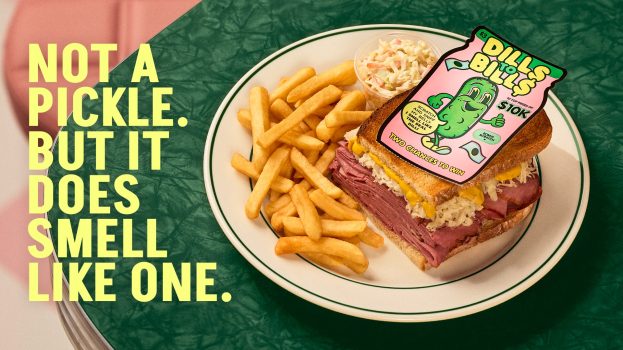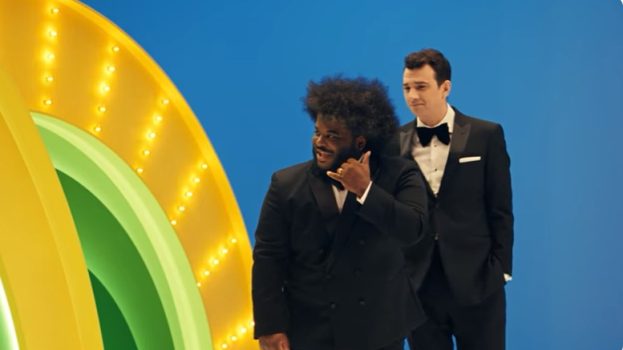In the 1983 flick Trading Places, a down-and-out Eddie Murphy explains the economics of the hood to his filthy rich co-stars; if he doesn’t return home clutching a G.I. Joe action figure with a ‘Kung-Fu Grip,’ he won’t be getting any action from his wife, who wants to present the coveted plaything to her kid for Christmas.
This scene depicts the renown of the toy way back when, and interestingly enough, Hasbro has just reintroduced the popular 70s ‘Kung-Fu Grip’ function to its 2002 G.I. Joe collection.
But the military man isn’t the only toy making a comeback from earlier decades, as marketers strive to connect with the nostalgic mind-set of parents post 9/11 by unveiling dated properties, often with a contemporary twist for today’s kids. There are a slew of them – Cabbage Patch Kids, Strawberry Shortcake, Incredible Hulk, Care Bears, and Masters of the Universe, to name a few.
According to Angela Scardillo, managing director of KidThink, Vancouver-based Palmer Jarvis DDB’s youth marketing division, reinvestment in retro toys is a sound strategy. ‘Parents want to recreate their own childhood experience or good memories and share them with their own families. There’s been an increase in nostalgic toys because of the desire for a sense of security after Sept. 11 and people are really demanding the familiar.’
Sales up
Indeed, retail sales of ‘traditional toys’ reached $25 billion in 2001, a 1.7% increase over the previous year, according to NPD Funworld, a division of Port Washington, N.Y.-based market information provider NPD Group. It’s not a stellar performance but still significant considering the tumultuous economy, according to the firm. Charging the way in growth were action figures and accessories, which posted a gain of 36% in dollar sales. Consumers are buying them because they feel like ‘they’re helping with the war effort,’ says Reyne Rice, director of marketing and communications at NPD Funworld.
Rice says the retro trend is also a backlash to the recent surge in high-tech toys, such as the robotic dogs that were so hot in 2000. ‘There’s a swing back and forth between high tech and back-to-basics every couple of years,’ she explains, adding that the new-and-improved Care Bears are ‘flying off the shelf’ so far. Cleveland, Ohio-based American Greetings brought back the plush toys earlier this year, except this time in more vibrant hues than the traditional pastels.
Along with Care Bears, the firm has dusted off and updated the look of another entertainment property from the ’80s – Strawberry Shortcake. The tiny, orange-headed doll – she now sports jeans and a striped top instead of a hokey dress with green-and-white leggings – will stand on store shelves once again in 2003 alongside her sister Apple Dumpling and other scented pals. American Greetings hooked up with L.A.-based DIC Entertainment and toy partner Bandai America in Cypress, Calif., for the North American launch, which will include a direct-to-video release, and a licensing program.
‘This is a property that was exceptionally successful in the ’80s…it did US$100 million in the first year alone,’ explains Randi Bregman, president of Toronto-based Venture Licensing, a division of Kaleidoscope Entertainment, which will handle licensing deals north of the border. ‘All the girls that watched [the show] and played with [the toys] are moms now. If you loved the TV show, and it fulfilled a certain need, you want to share that with your kids.’
Bregman says virtually all categories that appeal to girls – the target demo is 3-8s – will be rolled into the program. Shortcake already has 17 licensees onboard in the U.S., including Sara Lee’s hosiery division and ES Originals footwear. As for the toy collection, it will encompass a variety of action-type figures and plush dolls, games and puzzles, as well as the video, which will likely be pre-launched on a Canadian cartoon network, still to be determined. U.S.-produced TV advertising for Shortcake, still on the creative drawing board, will hit airwaves next spring.
Toys for boys
From the same heady decade, the musclehead action figure He-Man and his Masters of the Universe were pulled out of the closet by Mattel last month. Paula Dubecki, assistant product manager for male action figures at Mattel’s Mississauga office, says the firm is trying to recapture the property’s success of 20 years ago, when it was a $2-billion brand. Here too, the product has been tweaked; for instance, the more modern Castle Grayskull playset has an imbedded chip that recognizes the various characters.
‘Masters of the Universe is sort of a timeless story of good versus evil, and He-Man is a great character – heroic and noble,’ says Dubecki. ‘So he’s aspirational, but mortal. He has weaknesses and kids will be attracted to that.’
Commercials created by Mattel’s American AOR San Francisco-based Foote Cone & Belding, targeting boys aged five to nine, will ‘show key benefits to the product’ and tie in tightly with the Masters toon that launched on YTV in September, points out Dubecki, who adds that a promotion is also driving viewers online to win prizes.
During the summer months, a grassroots initiative aimed to cause a pre-buzz. Activity kits were sent to 40 camps across Canada, stocked with videos of the original series and colouring gear to get ‘the next generation of kids engaged with the characters.’
Matchless Matchbox
Mattel is also revving up its marketing engine for some of its other retro brands, such as Matchbox, the miniature toy automobile collection that turned 50 last month. Special edition vehicles, adorned with a gold, commemorative seal, are on sale at mass retailers like Zellers, Wal-Mart and Toys ‘R Us; the cars are housed in splashy, fire-engine red anniversary packaging.
‘Matchbox has always been focused on the cool factor, since it has the vintage mentality,’ says Grant Chapman, product manager for Mattel Canada’s wheels division, who explains that there are two demographic segments – kids and adult collectors. ‘And parents know it’s synonymous with quality, so they want to pass it on to their kids.’
When it comes to their pint-size consumers, Matchbox’s current position is focused on rescue (also popular with kids post 9/11), although the advertising, to be aired later this fall, is also heavily mom-focused; spots sporting the tagline ‘Matchbox to the rescue’ will depict how the playthings are perfect for ‘oversized imaginations.’ There is constant evolution to the lineup as well, adds Chapman, who points out that an upcoming edition has been influenced by the show Crocodile Hunter.
An exclusive apparel program with Zellers is also currently rolling out nationwide, including everything from Matchbox-logo’d tees and baseball caps to shoes and sunglasses, in an attempt to further build the brand.
Similarly, the firm’s Hot Wheels line will celebrate its 35th anniversary later this year and Mattel plans to make a big deal out of that too. Chapman won’t give too many details, but says kids will somehow be able to drive on Highway 35, a fictitious road, in a race around the world, while a contest will enable participants to collect tokens for the ultimate Hot Wheels track, which is worth $300 at retail. The entire initiative will be reinforced by a TV, print and Internet campaign, and possibly cinema as well. Explains Chapman: ‘We’ll be spending over $350,000 on marketing, which is pretty significant for a brand that generates $35 million in Canada.’
Spidey spawns Hulk
Other retro entertainment characters have hit the silver screen recently, and after this summer’s success of Spider-Man – backed by over $40 million in additional media by promotional partners – Universal Studios hopes fellow Marvel hero The Incredible Hulk can mimic Spidey’s explosion in popularity next year. ‘People are generally looking to entertainment more than ever for escapism, and fantasy heroes are a positive outlet for people to tap into,’ explains Rosalie Ward, director of licensing and retail at the studio’s Toronto offices.
Ward says there are broad licensing opportunities for the Ang Lee-directed film because of a wide target range. Toys are an obvious fit, but Universal is hoping Hulk’s wild, green face will appear on everything from clothing to toys, stationery, candies and video games, all skewed to boys.
So far, the movie release of Scooby-Doo, as well as its exposure on Teletoon has been a windfall for Toronto-based Irwin Toys. (Teletoon is currently airing the original series, but a new fall show from Warner Bros. called What’s New Scooby-Doo? is currently being spotlighted in an ad campaign.)
Sales of Irwin’s Scooby-branded action figures, plush toys, games and puzzles, on the market for four years now, have been ‘exceptionally strong’ lately, points out Michael Feraday, VP of marketing. ‘Sales have been double what they were last year and we expect to be up 50% in volume,’ he says.
This fall, Irwin is highlighting specific toys in its U.S.-originated TV creative, such as a plush Scared Silly Scooby, whose head twirls around in imitation of the toon character. Says Feraday: ‘You have to focus on what makes Scooby different than other properties, such as tying into an element of the show.’
Shrinky success
Spin Master Toys, also of Toronto, has similarly savoured success with its two-year-old retro toy, Shrinky Dinks, originally popular in the ’70s and ’80s; in fact, during the last holiday season, some U.S. retailers resorted to air freighting the product in. ‘We did even better than our expectations,’ says Conor Forkan, brand manager. ‘We couldn’t produce it fast enough.’
Shrinky Dinks was unveiled to tykes with TV spots that incorporated the jingle, ‘If you can think it, you can shrink it,’ as well as a strong PR effort directed at parents, which led to ink in everything from the Wall Street Journal to the Toronto Star. ‘Nostalgia had a part in that, but we’re pretty innovative when it comes to PR,’ says Andrew Kamondy, a spokesperson at the company, who isn’t about to give away any secrets. This fall, the Shrinky Dinks collection is also being updated with 3-D playsets (as opposed to the usual flat patterns) featuring, for example, a Spider-Man secret lab or Hello Kitty House, in order to keep kids coming back for more.
Despite all the hyperbole, not all observers are ecstatic about the revivification of retro toys.
Carol Green, president of Richmond Hill, Ont.-based consultancy Children’s Creative Marketing, is disappointed in the lack of emphasis on brand-new character creations. Green, who worked on toys like Strawberry Shortcake for American Greetings from 1983 to 1988, says this is because retailers aren’t as supportive of new brands. ‘Shareholders are looking for excellent returns and if the property fails, it goes right to the bottom line,’ she says. ‘There’s fear and hesitation [about new toys], so the idea is, ‘we’ll bring back something that was relatively successful in the past, because we know it’s a proven entity.”
Plus, just because a toy was considered wicked in the ’80s, doesn’t mean it will resonate with kids today, she adds. ‘You have to rely on a lot of hype and marketing to push a program to a new audience.’ In other words, treat it like it is brand new.
Spin Master Toys down with breakin’
Backspins and handspins have become de rigueur again, only this time minus the boom box on the shoulder. That’s right, today’s youth are flipping over breakdancing – now known as B-boying and B-girling – and Spin Master Toys hopes to capitalize on the trend, with a new line of figures, aptly named B-Boyz.
‘Just from watching hours of MuchMusic and MTV, we kept noticing the resurgence of breakdancing,’ says Conor Forkan, brand manager, who explains that ‘breakin” resurfaced underground but is now going mainstream again. ‘Nelly Furtado has breakers on tour with her,’ he adds, as proof.
At the Rock Steady Crew 25th Anniversary in New York this summer, where the dolls debuted, all 500 pieces on-hand sold out in two days. The event is a B-boy competition; the fact that B-Boyz can actually bust a move, thanks to a rotary mechanism and break rod, probably helped catch the eye of passersby.
For now, the breakers will sell in niche, hip hop clothing boutiques; mass chains will be added to the distribution list next year. There will be no advertising support yet either, adds Forkan. ‘We’ll build up steam with grassroots and PR. We’re setting the trends for suburbanites for next year, by [targeting] people who are in the scene right now.’
Sure, but can they do the worm?























